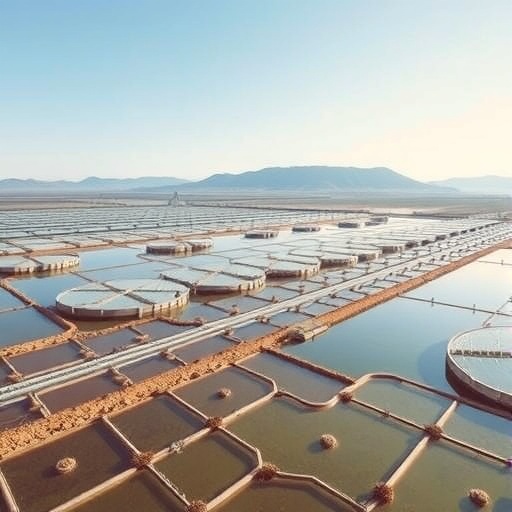Inland saline aquaculture has emerged as an innovative solution to combat the challenges presented by saline wastelands. As global climate patterns change, areas traditionally used for agriculture are becoming increasingly saline, rendering them unproductive. This has sparked interest in finding sustainable agricultural practices that not only reclaim these lands but also utilize their unique characteristics. A recent comprehensive review by Jahan et al. published in the journal “Discover Agriculture” delves into this emerging field. The authors meticulously analyze various aspects of inland saline aquaculture and its potential to transform barren lands into productive ecosystems.
The primary objective of inland saline aquaculture is to cultivate aquatic organisms in saline or brackish water sources. Unlike conventional aquaculture that relies on freshwater bodies, this method optimally utilizes saline water, which is abundant in many regions. Jahan et al. highlight how saline aquaculture can serve as an effective alternative for regions where freshwater resources are dwindling. This not only contributes to food security but also addresses the dire need for sustainable practices in aquaculture that do not compete with existing freshwater demands.
What stands out in the review is the potential for saline aquaculture to be integrated with other agricultural practices. The authors point out that there are methods such as polyculture, where multiple aquatic species are cultivated together, and integrated multi-trophic aquaculture, which can lead to higher yields and environmental sustainability. These techniques encourage biodiversity and mimic natural ecosystems, which allows aquaculturists to harvest a variety of organisms while minimizing waste. Jahan et al. underscored the significance of this integration as a pathway to rejuvenate saline wastelands.
Furthermore, the review provides an in-depth exploration of the species that thrive in saline environments. Species such as shrimp, certain fish, and mollusks have shown remarkable resilience to high salinity levels. Jahan et al. provide evidence from various studies that illustrate the growth rates and nutritional benefits of these species compared to their freshwater counterparts. This not only opens avenues for profitable aquaculture ventures but also reinforces the idea that saline environments can be productive, provided the right species are cultivated under suitable conditions.
The environmental implications of inland saline aquaculture are also significant. Saline aquaculture can help mitigate the salinization of surrounding soil by creating a controlled environment where excess salts can be managed. Jahan et al. discuss the importance of proper water management practices to maintain the health of both the aquaculture system and the surrounding ecosystems. This involves careful monitoring of salinity levels, nutrient balance, and water recycling, which are crucial for sustaining productivity while minimizing ecological damage.
Another remarkable point highlighted in the review is the socio-economic potential of inland saline aquaculture in rural communities. By promoting this practice, communities can create new job opportunities and stimulate local economies. The authors argue that the establishment of saline aquaculture could serve as a catalyst for rural development, particularly in regions that have been economically disadvantaged due to soil salinization. These communities can benefit from the production of high-value aquaculture products, thereby improving livelihoods and reducing poverty.
Moreover, Jahan et al. recognize the challenges that accompany the adoption of inland saline aquaculture. Factors such as lack of technical knowledge, inadequate infrastructure, and limited access to markets can hinder the successful implementation of saline aquaculture projects. The authors stress the importance of training programs and extension services to equip farmers with the knowledge required to effectively manage saline aquaculture systems. These efforts are vital in easing the transition from traditional farming practices to saline aquaculture.
The authors also emphasize the role of governmental policies and frameworks in promoting inland saline aquaculture. Supportive policies can facilitate research and development initiatives that aim to innovate sustainable practices in saline environments. Moreover, governments can play a significant role in providing the necessary infrastructure and financial backing for farmers to start saline aquaculture ventures, enhancing the overall feasibility of such projects.
Additionally, the review discusses the technological advancements that have the potential to revolutionize inland saline aquaculture. Innovations such as water quality monitoring systems and automated feeding technologies can optimize aquaculture operations, making them more efficient and productive. Jahan et al. provide examples of how these technologies are being successfully implemented in existing saline aquaculture systems and their positive impacts on yield and sustainability.
In conclusion, the research conducted by Jahan et al. underscores the transformative potential of inland saline aquaculture in reclaiming saline wastelands. By utilizing innovative aquaculture practices that are designed to thrive in saline conditions, it is possible to restore productivity to lands previously deemed unusable. The long-term benefits of such practices extend beyond agricultural production; they touch on environmental sustainability, economic development, and community resilience. As the world grapples with changing climate conditions and diminishing freshwater resources, the insights from this review make a compelling case for the advancement of inland saline aquaculture as an effective strategy for the future.
This comprehensive examination not only highlights the opportunities inherent in inland saline aquaculture but also acts as a call to action for researchers, policymakers, and communities to recognize and harness this potential. As aquaculture continues to grow as a global industry, the transition towards utilizing saline environments may well become a key aspect of sustainable development and food security in the coming decades.
Subject of Research: Inland saline aquaculture and its role in reclaiming saline wastelands.
Article Title: A review on the role of inland saline aquaculture in reclaiming saline wastelands.
Article References:
Jahan, I., Nanda, C., Reddy, A.K. et al. A review on the role of inland saline aquaculture in reclaiming saline wastelands.
Discov Agric 3, 256 (2025). https://doi.org/10.1007/s44279-025-00424-z
Image Credits: AI Generated
DOI: https://doi.org/10.1007/s44279-025-00424-z
Keywords: Inland saline aquaculture, saline wastelands, sustainable agriculture, brackish water, environmental impact, community development.
Tags: alternative aquaculture techniquesaquaculture in brackish waterclimate change impacts on agriculturefood security solutionsfreshwater resource managementinland saline aquacultureinnovative farming methodsintegrated agriculture systemsproductive ecosystems developmentsaline water utilizationsustainable agricultural practicestransforming saline wastelands





